
Menu

Jalpaiguri, nestled in the Dooars region of West Bengal, is not only rich in natural beauty but also in cultural heritage. Among its most treasured traditions are the folk music genres of Bhawaiya and Dham Gaan. These musical forms, deeply rooted in the daily lives and emotions of the people, reflect the region’s unique social fabric, language, and spiritual beliefs.
Bhawaiya is perhaps the most iconic folk music of the Rajbanshi community, which forms a significant part of Jalpaiguri’s population. Known for its soulful and melancholic tone, Bhawaiya typically explores themes of love, longing, separation, and rural life. Sung in the local dialect, the lyrics often depict the sorrow of women waiting for their lovers, who are away working as cart drivers, boatmen, or farmers. The music is slow and emotional, accompanied by traditional instruments like the dotara, sarinda, flute, and ektara. The haunting melodies and poetic storytelling give Bhawaiya a timeless, emotional depth that continues to resonate across generations.
Dham Gaan, on the other hand, is more vibrant and celebratory. It is often performed during religious occasions and village festivals. While Bhawaiya is introspective, Dham Gaan is expressive and communal, featuring lively rhythms and strong vocal interactions. It usually narrates mythological tales or moral stories and is performed in a call-and-response style. The performances are often accompanied by folk instruments like khol, dhol, and kartal.
Both Bhawaiya and Dham Gaan are more than just musical forms—they are living oral histories that preserve the ethos, values, and emotions of the local communities. Thanks to the efforts of cultural organizations and passionate artists, these musical treasures continue to thrive, reminding us of Jalpaiguri’s deep-rooted artistic soul.



